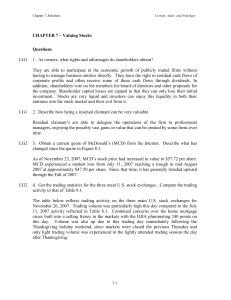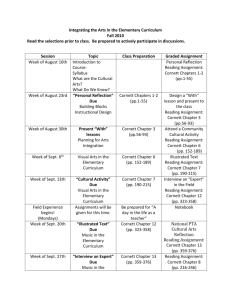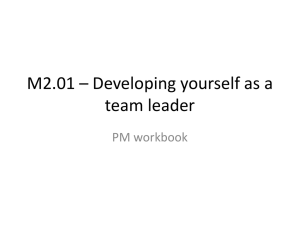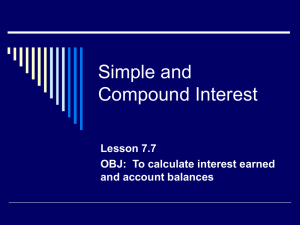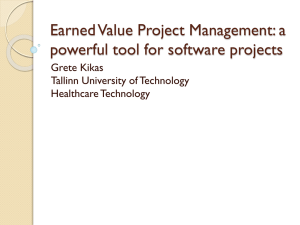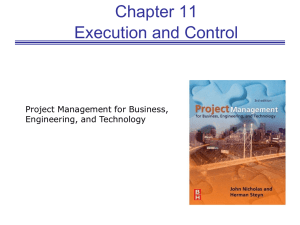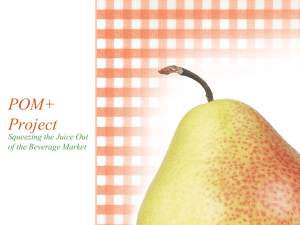CHAPTER 4 – ANALYSIS OF SINGLE CASH FLOWS
advertisement
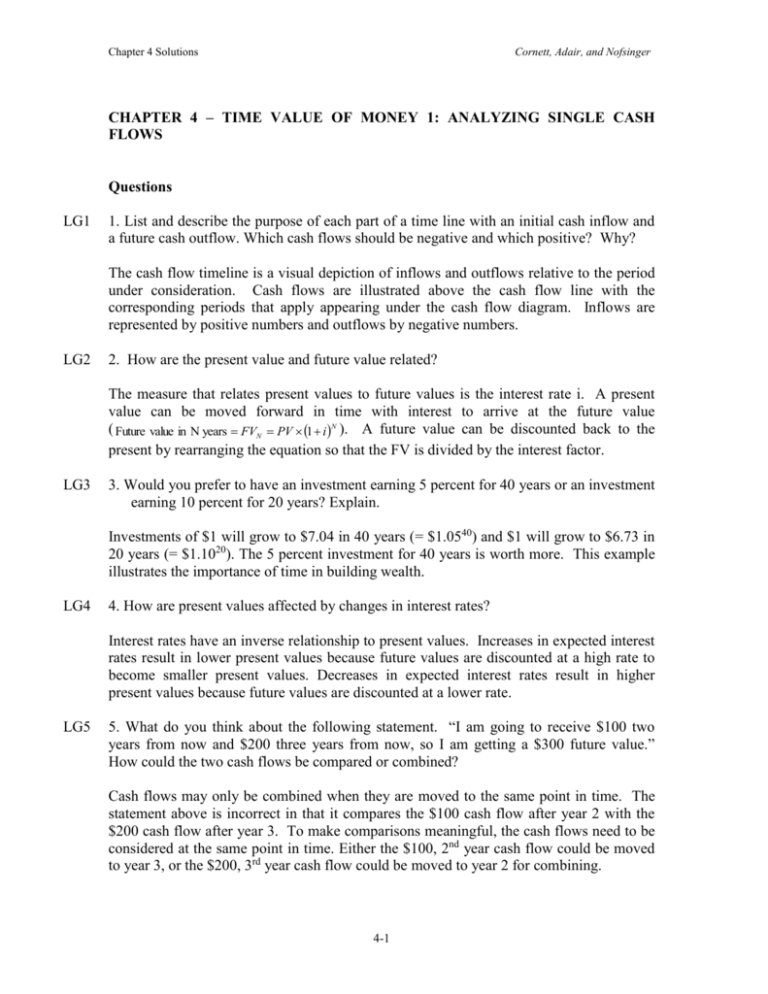
Chapter 4 Solutions Cornett, Adair, and Nofsinger CHAPTER 4 – TIME VALUE OF MONEY 1: ANALYZING SINGLE CASH FLOWS Questions LG1 1. List and describe the purpose of each part of a time line with an initial cash inflow and a future cash outflow. Which cash flows should be negative and which positive? Why? The cash flow timeline is a visual depiction of inflows and outflows relative to the period under consideration. Cash flows are illustrated above the cash flow line with the corresponding periods that apply appearing under the cash flow diagram. Inflows are represented by positive numbers and outflows by negative numbers. LG2 2. How are the present value and future value related? The measure that relates present values to future values is the interest rate i. A present value can be moved forward in time with interest to arrive at the future value ( Future value in N years FVN PV 1 i N ). A future value can be discounted back to the present by rearranging the equation so that the FV is divided by the interest factor. LG3 3. Would you prefer to have an investment earning 5 percent for 40 years or an investment earning 10 percent for 20 years? Explain. Investments of $1 will grow to $7.04 in 40 years (= $1.0540) and $1 will grow to $6.73 in 20 years (= $1.1020). The 5 percent investment for 40 years is worth more. This example illustrates the importance of time in building wealth. LG4 4. How are present values affected by changes in interest rates? Interest rates have an inverse relationship to present values. Increases in expected interest rates result in lower present values because future values are discounted at a high rate to become smaller present values. Decreases in expected interest rates result in higher present values because future values are discounted at a lower rate. LG5 5. What do you think about the following statement. “I am going to receive $100 two years from now and $200 three years from now, so I am getting a $300 future value.” How could the two cash flows be compared or combined? Cash flows may only be combined when they are moved to the same point in time. The statement above is incorrect in that it compares the $100 cash flow after year 2 with the $200 cash flow after year 3. To make comparisons meaningful, the cash flows need to be considered at the same point in time. Either the $100, 2nd year cash flow could be moved to year 3, or the $200, 3rd year cash flow could be moved to year 2 for combining. 4-1 Chapter 4 Solutions LG6 Cornett, Adair, and Nofsinger 6. Show how the Rule of 72 can be used to approximate the number of years to quadruple an investment. The Rule of 72 is a rule of thumb that approximates the amount of time necessary for an investment to double given a certain level of interest expressed in percentage form. Therefore, an investment of 8% interest will take approximately 9 years (= 72/8) to double according to the Rule of 72. It would then take another 9 years for this amount to double. Therefore, it would take 18 years for the original investment to quadruple at an 8 percent rate. LG7 7. Without making any computations, indicate which of each pair has a higher interest rate? a. $100 doubles to $200 in 5 years or 7 years. b. $500 increases in 4 years to $750 or to $800. c. $300 increases to $450 in 2 years or increases to $500 in 3 years. a. $100 doubling to $200 in 5 years has the higher interest rate. b. $500 increasing to $800 in 4 years has a higher interest rate. c. $300 increasing to $450 in 2 years has the higher interest rate. LG8 8. A $1,000 investment has doubled to $2,000 in 8 years because of a 9 percent rate of return. How much longer will it take for the investment to reach $4,000 if it continues to earn a 9 percent rate? The Rule of 72 predicted that $1000 will double to $2000 in 8 years at 9 percent interest. Another doubling from $2000 to $4000 will occur in eight more years at 9 percent, again predicted by the Rule of 72. Problems Basic Problems 4-1 Time Line Show the time line for a $300 cash inflow today, a $363 cash outflow in LG1 year two, and a 10 percent interest rate. The time line for this problem is: Cash Flow 300 Period 0 LG1 -363 10% 1 10% 2 years 4-2 Time Line Show the time line for a $400 cash outflow today, a $518 cash inflow in year three, and a 9% interest rate. 4-2 Chapter 4 Solutions Cornett, Adair, and Nofsinger The time line for this problem is: Cash Flow -400 Period 0 LG2 518 9% 1 9% 2 9% 3 years 4-3 One Year Future Value What is the future value of $500 deposited for one year earning a 9% interest rate annually. FVN = PV × (1 + i)N FV1 = 500 × (1 + 0.09)1 = 500 × 1.09 = 545 LG2 4-4 One Year Future Value What is the future value of $400 deposited for one year earning an interest rate of 11 percent per year? FVN = PV × (1 + i)N FV1 = 400 × (1 + 0.11)1 = 400 × 1.11 = 444 LG3 4-5 Multi-Year Future Value How much would be in your savings account in 8 years after depositing $150 today if the bank pays 7 percent per year? FVN = PV × (1 + i)N FV8 = 150 × (1 + 0.07)8 = 150 × 1.71819 = 257.73 LG3 4-6 Multi-Year Future Value Compute the value in 25 years of a $1,000 deposit earning 10 percent per year. FVN = PV × (1 + i)N FV25 = 1000 × (1 + 0.10)25 = 1000 × 10.83471 = 10,834.71 LG3 4-7 Compounding with Different Interest Rates A deposit of $350 earns the following interest rates: 8 percent in the first year, 7 percent in the second year, and 5 percent in the third year. What would be the third year future value? 4-3 Chapter 4 Solutions Cornett, Adair, and Nofsinger The time line for this problem is: Cash Flow -350 X Period 0 8% 1 7% 2 5% 3 years FV = PV × (1 + i) (1 + j) (1 + k) FV = 350 × (1 + 0.08) (1 + 0.07) (1 + 0.05) = 350 × 1.08 × 1.07 × 1.05 = 424.68 LG3 4-8 Compounding with Different Interest Rates A deposit of $750 earns interest rates of 10 percent in the first year and 12 percent in the second year. What would be the second year future value? The time line for this problem is: Cash Flow -750 Period 0 X 10% 1 12% 2 years FV = PV × (1 + i) (1 + j) FV = 750 × (1 + 0.10) (1 + 0.12) = 750 × 1.10 × 1.12 = 924.00 LG4 4-9 Discounting One Year What is the present value of a $250 payment in one year when the discount rate is 10 percent? PV = FV/(1+i) PV = 250/(1+0.10) = 250/1.10 = 227.27 LG4 4-10 Discounting One Year What is the present value of a $400 payment in one year when the discount rate is 7 percent? PV = FV/(1+i) PV = 400/(1+0.07) = 400/1.07 = 373.83 4-4 Chapter 4 Solutions LG4 Cornett, Adair, and Nofsinger 4-11 Present Value What is the present value of a $1,500 payment made in 5 years when the discount rate is 8 percent? PV = FV/(1+i)N PV = 1500/(1+0.08)5 = 1500/1.46933 = 1020.87 LG4 4-12 Present Value Compute the present value of a $850 payment made in 10 years when the discount rate is 12 percent. PV = FV/(1+i)N PV = 850/(1+0.12)10 = 850/3.10585 = 273.68 LG4 4-13 Present Value with Different Discount Rates Compute the present value of $1,000 paid in three years using the following discount rates; 6 percent in the first year, 7 percent in the second year, and 6 percent in the third year. PV = FV/[(1 + i) (1 + j) (1 + k)] PV = 1000/[(1 + 0.06) (1 +0.07) (1 + 0.06)] = 1000/[1.06 × 1.07 × 1.06] = 1000/1.2023 = 831.77 LG4 4-14 Present Value with Different Discount Rates Compute the present value of $5,000 paid in two years using the following discount rates; 8 percent in the first year and 7 percent in the second year. PV = FV/[(1 + i) (1 + j) ] PV = 5000/[(1 + 0.08) × (1 + 0.07)] = 5000/[1.08 × 1.07] = 5000/1.1556 = 4326.76 LG6 4-15 Rule of 72 Approximately how many years does it take to double a $100 investment when interest rates are 7 percent per year? N = 72/7 10.3 years LG6 4-16 Rule of 72 Approximately how many years does it take to double a $500 investment when interest rates are 10 percent per year? 4-5 Chapter 4 Solutions Cornett, Adair, and Nofsinger N = 72/10 7.2 years LG6 4-17 Rule of 72 Approximately what interest rate is needed to double an investment over 5 years? N = 72/5 14.4 years LG6 4-18 Rule of 72 Approximately what interest rate is earned when an investment doubles over 12 years? N = 72/12 6 percent LG7 4-19 Rates over One Year Determine the interest rate earned on a $1,500 deposit when $1,700 is paid back in one year. 1500×(1 + i) = 1700; Solving for i yields 13.33% LG7 4-20 Rates over One Year Determine the interest rate earned on a $2,300 deposit when $2,700 is paid back in one year. 2300×(1 + i) = 2700; Solving for i yields 17.39% Intermediate Problems 4-21 Interest-on-Interest Consider a $1,000 deposit earning 8 percent interest per year LG3 for 5 years. What is the future value, and how much total interest is earned on the original deposit vs. how much is interest earned on interest? The $1000 investment will grow to a future value of $1,469.33 [= FV5 = 1000×(1+0.08)5], assuming compounded interest over the 5 years. The total interest earned is $469.33. The interest earned on the original investment is $80 per years for 5 years, or $400. The interest earned on the interest is the difference $69.33 [= $469.33 − $400]. LG3 4-22 Interest-on-Interest Consider a $5,000 deposit earning 9 percent interest per year for 10 years. What is the future value, and how much total interest is earned on the original deposit and how much is interest earned on interest? The $5000 investment will grow to a future value of $11,836.82 [= FV10 = 5000×(1+0.09)10], assuming compounded interest over the 10 years. The total interest earned is $6,836.82. The interest earned on the original investment is $450 per years for 10 years, or $4,500. The interest earned on the interest is the difference $2,336.82 [= $6836.82 − $4500]. 4-6 Chapter 4 Solutions LG5 Cornett, Adair, and Nofsinger 4-23 Comparing Cash Flows What would be more valuable, receiving $500 today or receiving $625 in three years when interest rates are 9 percent? Why? PV = FV/(1+i)N PV = 625/(1+0.09)3 = 625/1.295029 = 482.61 The present value of $625 to be paid in three years at 9% interest is $482.61. This amount is worth less than $500 received today. Therefore the $500 payment made today is more valuable. LG5 4-24 Comparing Cash Flows Which cash flow would you rather pay, $400 today or $500 in two years when interest rates are 10 percent? Why? PV = FV/(1+i)N PV = 500/(1+0.10)2 = 500/1.21 = 413.22 The present value of $500 to be paid in two years at 10% interest is $413.22. This amount is higher than $400 received today. Therefore, paying the $400 today is cheaper. LG5 4-25 Moving Cash Flows What is the value in year 3 of a $700 cash flow made in year 7 when interest rates are 10 percent? PV = FV/(1+i)N PV = 700/(1+0.10)(7-3) = 700/1.4641 = 478.11 LG5 4-26 Moving Cash Flows What is the value in year 4 of a $900 cash flow made in year 6 when interest rates are 8 percent? PV = FV/(1+i)N PV = 900/(1+0.08)(6-4) = 900/1.1664 = 771.60 LG5 4-27 Moving Cash Flows What is the value in year 10 of a $1,000 cash flow made in year 5 when interest rates are 9 percent? FVN = PV × (1 + i)N FV(10-5) = PV × (1 + i)(10-5) 4-7 Chapter 4 Solutions Cornett, Adair, and Nofsinger FV12 = 1000 × (1 + 0.09)5 = 1000 × 1.5386 = 1538.62 LG5 4-28 Moving Cash Flows What is the value in year 15 of a $250 cash flow made in year 3 when interest rates are 12 percent? FVN = PV × (1 + i)N FV(15-3) = PV × (1 + i)(15-3) FV12 = 250 × (1 + 0.12)12 = 250 × 3.89598 = 973.99 LG7 4-29 Solving for Rates What annual rate of return is earned on a $1,000 investment when it grows to $2,500 in six years? FVN = PV × (1 + i)N 2,500 = 1,000 × (1 + i)6 (1 + i)6 = 2500/1000 (1 + i)6 = 2.5 i = (2.5)(1/6) -1 = 0.165 or 16.5% LG7 4-30 Solving for Rates What annual rate of return is earned on a $5,000 investment when it grows to $9,500 in five years? FVN = PV × (1 + i)N 9,500 = 5,000 × (1 + i)5 (1 + i)5 = 9500/5000 (1 + i)5 = 1.9 i = (1.9)(1/5) -1 = 0.137 or 13.7% LG8 4-31 Solving for Time How many years (and months) will it take $2 million to grow to $5 million with an annual interest rate of 7 percent? FVN = PV × (1 + i)N $5 million = $2 million × (1 + 0.07)N (1.07)N = 5/2 (the millions cancel) ln (1.07)N = ln 2.5 N × ln 1.07 = ln 2.5 N = ln 2.5/ln 1.07 = 0.916290732/0.067658648 = 13.54 years = 13 years, 6.5 months OR use footnote 4 formula: N = ln(fv/pv)/ln(1+i) = ln(5000/2000)/ln(1.07) 4-8 Chapter 4 Solutions Cornett, Adair, and Nofsinger = 13.54 years = 13 years, 6.5 months LG8 4-32 Solving for Time How long will it take $2,000 to reach $6,000 when it grows at 10 percent per year? FVN = PV × (1 + i)N 6,000 = 2,000 × (1 + 0.10)N (1.10)N = 6/2 (the thousands cancel) ln (1.10)N = ln 3 N × ln 1.10 = ln 3 N = ln 3/ln 1.10 = 1.098612289/0.09531018 = 11.53 years = 11 years, 6.3 months OR use footnote 4 formula: N = ln(fv/pv)/ln(1+i) = ln(6000/2000)/ln(1.10) = 11.53 years = 11 years, 6.3 months Advanced Problems LG2 4-33 Future Value At age 30 you invest $1,000 that earns 9 percent each year. At age 40 you invest $1,000 that earns 12 percent per year. In which case would you have more money at age 60? FVAge 60 = PVAge 30 × (1 + i)Years until age 60 FVAge 60 = 1000 × (1.09)30 = 1,000 × 13.267678 = 13,267.68 FVAge 60 = PVAge 40 × (1 + i)Years until age 60 FVAge 60 = 1000 × (1.12)20 = 1,000 × 9.64629 = 9,646.29 The investment of $1,000 at age 30 yields more money at age 60, even though the interest rate is lower. This illustrates the importance of starting to invest earlier in life. LG2 4-34 Future Value At age 25 you invest $1,500 that earns 8 percent each year. At age 40 you invest $1,500 that earns 11 percent per year. In which case would you have more money at age 65? FVAge 65 = PVAge 25 × (1 + i)Years until age 60 FVAge 65 = 1,500 × (1.08)40 = 1,500 × 21.7245215 = 32,586.78 4-9 Chapter 4 Solutions Cornett, Adair, and Nofsinger FVAge 65 = PVAge 40 × (1 + i)Years until age 60 FVAge 65 = 1000 × (1.11)25 = 1,500 × 13.5854638 = 20,378.20 The investment of $1,500 at age 25 yields more money at age 65, even though the interest rate is lower. This illustrates the importance of starting to invest earlier in life. LG7 4-35 Solving for Rates You invested $2,000 in the stock market one year ago. Today, the investment is valued at $1,500. What return did you earn? What return would you need to get next year to break even overall? FVN = PV × (1 + i)N 1,500 = 2,000 × (1 + i)1 (1 + i) = 1,500/2,000 i = (0.75) -1 = −0.25, or −25% (first year return is negative) FVN = PV × (1 + i)N 2,000 = 1,500 × (1 + i)1 (1 + i) = 2,000/1,500 i = (2/1.5) -1 = 0.3333 or 33.33% (second year return needs to be higher to compensate for the loss) LG7 4-36 Solving for Rates You invested $3,000 in the stock market one year ago. Today, the investment is valued at $3,500. What return did you earn? What return would you suffer next year for your investment to be valued at the original $3,000? FVN = PV × (1 + i)N 3,500 = 3,000 × (1 + i)1 (1 + i) = 3,500/3,000 i = (35/30) -1 = 0.1667 or 16.67% (first year return is positive) FVN = PV × (1 + i)N 3,000 = 3,500 × (1 + i)1 (1 + i) = 3,000/3,500 i = (30/35) -1 = -0.143 or −14.3% (second year return is negative) LG7 4-37 Solving for Rates What annual rate of return is earned on a $4,000 investment made in year 2 when it grows to $7,000 by the end of year six? FVN = PV × (1 + i)N 7,000 = 4,000 × (1 + i)4 (1 + i) 4 = 7,000/4,000 4-10 Chapter 4 Solutions Cornett, Adair, and Nofsinger i = (1.75) (1/4) -1 = 1.1502 – 1 = 0.1502 or 15.02% LG7 4-38 Solving for Rates What annual rate of return is implied on a $2,500 loan taken next year when $3,500 must be repaid in year 4? FVN = PV × (1 + i)N 3,500 = 2,500 × (1 + i)(4-1) (1 + i)3 = 3,500/2,500 i = (1.40) (1/3) - 1 = 0.1187 or 11.87% (note, this is from the lender’s perspective) LG2&4 4-39 General TVM Ten years ago, Hailey invested $2,000 and locked in a 9 percent annual interest rate for 30 years (end 20 years from now). Aidan can make a twenty year investment today and lock in a 10 percent interest rate. How much money should he invest now in order to have the same amount of money in 20 years as Hailey? First determine how much Hailey will have. FV30 = PV × (1 + i)30 FV30 = 2,000 × (1 + 0.09)30 = 2,000 × 13.26757847 = 26,535.36 (Hailey’s FV in 30 years) So Aidan will have to deposit: PV = FV/(1+i)N PV = 26,535.36/(1+0.10)20 = 26,535.36/0.148643628 = 3,944.31 LG5 4-40 Moving Cash Flows You are scheduled to receive a $500 cash flow in one year, a $1,000 cash flow in two years, and pay a $800 payment in three years. If interest rates are 10 percent per year, what is the combined present value of these cash flows? The timeline of this problem is Cash Flow ? Period 0 500 1 1000 10% 2 First, discount the $500 to year 0: PV = 500/(1+0.10) = 454.55 Then discount the $1000 to year 0: PV = 1000/(1+0.10)2 = 826.45 Discount the -$800 to year 0: PV = -800/(1+0.10)3 = -601.05 Now sum up the cash flows: 4-11 -800 3 years Chapter 4 Solutions Cornett, Adair, and Nofsinger 454.55 + 826.45 – 601.05 = 679.95 4-41 Excel Problem Oil prices have increased a great deal in the last decade. The table below shows the average oil price for each year since 1949. Many companies use oil products as a resource in their own business operations (like airline firms and manufacturers of plastic products). Managers of these firms will keep a close watch on how rising oil prices will impact their costs. The interest rate in the PV/FV equations can also be interpreted as a growth rate in sales, costs, profits, etc. (see Example 4-5). Average Oil Prices Year 1949 1950 1951 1952 1953 1954 1955 1956 1957 1958 1959 1960 1961 1962 1963 1964 1965 1966 1967 1968 per barrel $2.54 $2.51 $2.53 $2.53 $2.68 $2.78 $2.77 $2.79 $3.09 $3.01 $2.90 $2.88 $2.89 $2.90 $2.89 $2.88 $2.86 $2.88 $2.92 $2.94 Year 1969 1970 1971 1972 1973 1974 1975 1976 1977 1978 1979 1980 1981 1982 1983 1984 1985 1986 1987 1988 per barrel $3.09 $3.18 $3.39 $3.39 $3.89 $6.87 $7.67 $8.19 $8.57 $9.00 $12.64 $21.59 $31.77 $28.52 $26.19 $25.88 $24.09 $12.51 $15.40 $12.58 Year 1989 1990 1991 1992 1993 1994 1995 1996 1997 1998 1999 2000 2001 2002 2003 2004 2005 2006 2007 per barrel $15.86 $20.03 $16.54 $15.99 $14.25 $13.19 $14.62 $18.46 $17.23 $10.87 $15.56 $26.72 $21.84 $22.51 $27.54 $38.93 $46.47 $58.30 $64.67 a. Using the 1949 oil price and the 1968 oil price, compute the annual growth rate in oil prices during those 19 years. =RATE(19,0,-2.54,2.94) = 0.77% b. Compute the annual growth rate between 1969 and 1988 and between 1989 and 2007. =RATE(19,0,-3.09,12.58) = 7.67% for 1969 to 1988 =RATE(18,0,-15.86,64.67) = 8.12% for 1989 to 2007 4-12 Chapter 4 Solutions Cornett, Adair, and Nofsinger c. Given the price of oil in 2007 and your computed growth rate between 1989 and 2007, compute the future price of oil in 2010, 2015, and 2020. =FV(8.12%,3,0,64.67,0) = 81.74 in 2010 =FV(8.12%,8,0,64.67,0) = 120.78 in 2015 =FV(8.12%,13,0,64.67,0) = 178.46 in 2020 Research It! Stock Market Returns What kind of returns might you expect in the stock market? One way to measure how the stock market has performed is to examine the rate of return of the S&P 500 Index. To see historical returns of the S&P 500 Index, go to Standard & Poor’s web site at www2.standardandpoors.com. Click on “Indices” in the side menu and then “View Total Return” under the S&P 500 title. Lastly, scroll down and click the link “S&P 500 historical returns.” This opens an Excel spreadsheet of returns over various periods. Examine the 1 year, 5 year, and 10 year total returns over time. What do you conclude about the returns during each of these periods? SOLUTION: The actual data shown will depend on the date the exercise is conducted. However, the top portion may look like: STANDARD & POOR'S INDEX SERVICES S&P 500 MONTHLY RETURNS, OCTOBER 31, 2007 1 MONTH MONTH OF 12 MONTH PRICE PRICE 1 MONTH 3MONTH 6MONTH 1 YEAR 3 YEAR 5 YEARS 10 YEARS TOTAL TOTAL CLOSE CHANGE CHANGE CHANGE CHANGE CHANGE CHANGE CHANGE CHANGE RETURN RETURN 10/2007 1549.38 22.63 1.48% 6.47% 4.52% 12.44% 37.09% 74.92% 69.40% 1.59% 14.56% 09/2007 1526.75 52.76 3.58% 1.56% 7.45% 14.29% 36.98% 87.27% 61.17% 3.74% 16.44% 08/2007 1473.99 18.72 1.29% -3.70% 4.77% 13.05% 33.48% 60.90% 63.87% 1.50% 15.13% 07/2007 1455.27 -48.08 -3.20% -1.83% 1.18% 13.99% 32.09% 59.64% 52.49% -3.10% 16.13% 06/2007 1503.35 -27.27 -1.78% 5.81% 6.00% 18.36% 31.78% 51.88% 69.84% -1.66% 20.59% The one year total returns are highly volatile. They can be very large and positive and very large and negative. The total return for five year periods are much less volatile, but can still be quite negative during some periods. The total return for ten year periods are never negative. 4-13 Chapter 4 Solutions Cornett, Adair, and Nofsinger Integrated Mini Case Investing in Gold People have had a fascination with gold for thousands of years. Archaeologists have discovered gold jewelry in Southern Iraq dating to 3000 BC, and gold ornaments in Peru dating to 1200 BC. The ancient Egyptians were masters in the use of gold for jewelry, ornaments, and economic exchange. By 1000 BC, squares of gold were a legal form of money in China. The Romans issued a popular gold coin called the Aureus (aureus is the Latin word for gold). By 1100 AD, gold coins had been issued by several European countries. Gold has been a highly sought after asset all over the world and has always retained at least some economic value over thousands of years. The United States has had a very chaotic history with gold. For example, in the Great Depression, President Franklin D. Roosevelt banned the export of gold and ordered U.S. citizens to hand in all the gold they possessed. It was not until the end of 1974 that the ban on gold ownership by U.S. citizens was lifted. By 1986, the U.S. government’s attitude on gold ownership had completely turned around, as evidenced by the resumption of the U.S. Mint’s production of gold coins with the American Eagle. However, U.S. investors have little more than 30 years of gold-investing experience. Figure 4.5 shows how the price of gold per Troy ounce has changed since 1974. Figure 4.5 December Gold Prices Since 1974 900.00 X 800.00 Gold peaked at $870.00 during trading on January 21, 1980. 700.00 Gold Price per Oz. ($) 600.00 500.00 400.00 300.00 200.00 100.00 Year Data Source: Kitco (www.kitco.com) 4-14 2007 2004 2001 1998 1995 1992 1989 1986 1983 1980 1977 1974 0.00 Chapter 4 Solutions Cornett, Adair, and Nofsinger These end-of-December prices do not illustrate the true magnitude of the price bubble in gold prices that occurred in 1980.The price of gold increased from $512 at the end of 1979 to a top of $870 on January 21, 1980. The subsequent crash in the price of gold was just as spectacular. The annual returns of gold are shown in Table 4.5. Gold prices have been very volatile, increasing dramatically for one or two years and then experiencing significant declines the next year or two. Table 4.5 Annual Gold Returns Since 1975 Year 1975 1976 1977 1978 1979 1980 1981 1982 1983 1984 1985 1986 1987 1988 1989 1990 1991 Annual Gold Return -19.86% -4.10% 22.64% 37.01% 126.55% 15.19% -32.60% 14.94% -16.31% -19.19% 5.68% 21.31% 22.21% -15.26% -2.84% -1.47% -10.07% Year 1992 1993 1994 1995 1996 1997 1998 1999 2000 2001 2002 2003 2004 2005 2006 2007 Annual Gold Return -5.75% 17.68% -2.17% 0.98% -4.59% -21.41% -0.83% 0.85% -5.44% 0.75% 25.57% 19.89% 4.65% 17.77% 23.20% 31.92% Data Source: Kitco (www.kitco.com) a. Compute the rate of return in gold prices that occurred during the three weeks between the last day of 1979 and the January 21, 1980 top. SOLUTION: solve for i, 870 = 512 × (1 + i) i = 870/512 – 1 = 0.6992 = 69.92% b. By the end of 1980, gold had dropped to $589.75 per Troy ounce. Compute the rate of return from the top to the end of 1980. SOLUTION: solve for i, 589.75 = 870 × (1 + i) i = 589.75/870 – 1 = -0.3221 = -32.22% 4-15 Chapter 4 Solutions Cornett, Adair, and Nofsinger c. Imagine that you invested $1,000 in gold at the end of 1999. Use the returns in Table 4.5 to determine the value of the investment at the end of 2007. SOLUTION: Year 1999 2000 2001 2002 2003 2004 2005 2006 2007 Annual Gold Return 0.85% -5.44% 0.75% 25.57% 19.89% 4.65% 17.77% 23.20% 31.92% Investment Factor 0.9456 1.0075 1.2557 1.1989 1.0465 1.1777 1.2320 1.3192 4-16 Value 1,000.00 945.60 952.69 1,196.30 1,434.24 1,500.93 1,767.65 2,177.74 2,872.87
